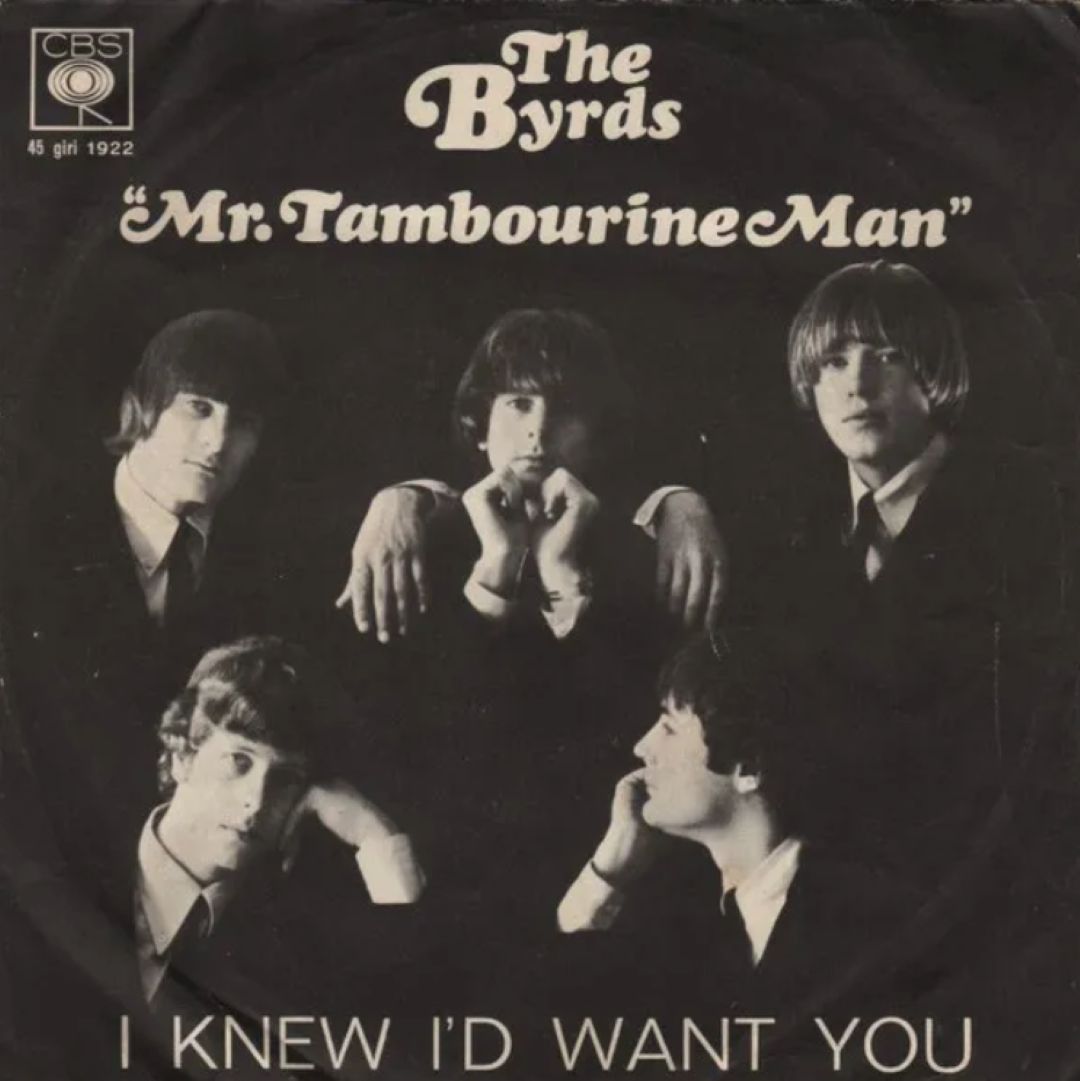🌀 From Poet to Pop: A Dylan Song Reimagined
When Bob Dylan first wrote “Mr. Tambourine Man” in early 1964, it was long, surreal, and far from radio-ready. Clocking in at over five minutes and filled with vivid poetic imagery, it was a beautiful, rambling folk tune that didn’t scream “chart hit.”
But when The Byrds—five young musicians from Los Angeles with Beatles haircuts and folk roots—got their hands on it, they saw something else. Something electric.
Roger McGuinn’s jangly 12-string Rickenbacker guitar, Michael Clarke’s crisp drumming, and those pristine vocal harmonies would turn Dylan’s folk anthem into a shimmering, three-minute pop masterpiece.

🎶 One Verse, One Voice—and One Big Gamble
The Byrds only used one of Dylan’s four verses. And rather than singing in unison like folk singers, they arranged their vocals like The Beatles—tight, harmonized, polished.
McGuinn’s solo vocal gave it a cool detachment. The chiming guitar riff gave it a sound no one had heard before.
Folk purists cried foul. But teenagers? They couldn’t get enough.
“Mr. Tambourine Man” was released in April 1965.
By July 22, 1965, it had reached #1 in the UK, knocking off The Hollies and The Animals—and beating even Dylan himself to the top of the British charts.
Why the UK Fell in Love
The Beatles had just opened the British ears to American rock ’n’ roll and harmonies. But The Byrds added something new: an intellectual cool, a touch of surrealism, and that signature “jangle” that felt like both folk and space-age at once.
The song sounded like a dream—but one you could dance to.
In a moment when youth culture was exploding, “Mr. Tambourine Man” felt like a perfect expression of young curiosity, escapism, and poetic rebellion.
🧠 Dylan, Without Dylan
Ironically, Dylan didn’t play on the recording. The Byrds didn’t even play all the instruments themselves—session legends like Hal Blaine and Larry Knechtel helped fill in the rhythm section.
But this wasn’t about authenticity. It was about innovation.
The song bridged two worlds: folk’s deep lyricism and rock’s commercial punch.
And in doing so, it brought Dylan’s genius to the masses in a new way—cleaned up, sped up, radio-ready.
🌟 A Genre Is Born: Folk Rock
“Mr. Tambourine Man” didn’t just top the charts.
It launched an entire genre: folk rock.
It made Dylan go electric.
It inspired Simon & Garfunkel, The Mamas & the Papas, Buffalo Springfield, and later, even Bruce Springsteen.
And it proved that smart lyrics and catchy hooks didn’t have to live in different worlds.
This wasn’t the end of folk. It was its evolution.
🎤 Lyrics That Still Feel Like a Trip
“Take me for a trip upon your magic swirling ship…”
Even stripped to one verse, Dylan’s lyrics painted images few pop songs dared to:
—a pied piper of dreams
—a dance beyond time
—a yearning for escape that didn’t need to be literal
Decades later, the line between poetry and pop is thinner thanks to this very song.
🎧 The Sound That Sparked a Thousand Bands
Roger McGuinn’s 12-string guitar riff became one of the most imitated sounds of the 1960s.
Tom Petty, R.E.M., The Smiths, and even The Church would all chase that chime.
And every band with a folk bent and electric dreams owes something to “Mr. Tambourine Man.”
🎵 Song Highlight
“Mr. Tambourine Man” – The Byrds
-
Released: April 12, 1965
-
UK Chart: #1 (July 22, 1965)
-
Genre: Folk Rock
-
Writers: Bob Dylan
-
Performed by: The Byrds
-
Legacy: One of the first and most successful folk-rock singles ever, and the song that turned Bob Dylan’s words into a pop phenomenon.
📜 A Few Surprising Facts
-
Only Roger McGuinn from The Byrds played on the original single—the rest were studio musicians.
-
Dylan initially wasn’t sure about giving the song to them—but later called it “beautiful.”
-
The Byrds’ version was only 2:30 long, a radio-friendly edit of Dylan’s much longer original.
-
The success of the cover inspired Dylan to go electric at the Newport Folk Festival just weeks later.
-
The term “folk rock” was coined by the press to describe this very song.
🧨 Final Thought
“Mr. Tambourine Man” didn’t just bring Bob Dylan into pop culture.
It announced a new kind of song—where poetry and pop could meet, dance, and shake up the charts.
In three minutes, The Byrds helped turn the ’60s into a whole new soundscape.
And it all started with a tambourine.